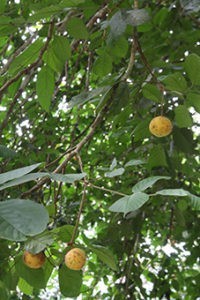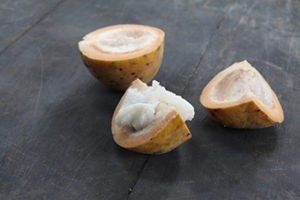Scientific name: Sandoricum koetjape
Common name: Santol
Lao name: Thong
Plant family: Meliaceae
The Santol is native to Indo-china and West Malesia, although it is now cultivated throughout SE Asia. They grow below 1,000m altitude and are hardy trees, able to tolerate a long dry season.

Santol fruit on the tree
Santol trees are semi-deciduous (meaning they lose their leaves for a very short time), can grow up to 30m in height and when cut produce a milky latex. Each leaf of a Santol is divided into three leaflets, so it looks like there are always sets of three leaves together, when in fact it’s just one. These leaflets are a shiny green on top and a pale green with fine hairs underneath. They change to red-yellow before they fall from the tree. They produce many small, fragrant yellow-green flowers that then become golden yellow fruit from June – August. These fruit are round and approximately the size of a small apple.
The 2-5 seeds inside are surrounded by a sweet white flesh, although the rest of the fruit can also be eaten once the skin in removed. Laos people often peel the fruit and then soak them for a while to soften the flesh. In Laos they are only eaten raw, but in other countries they are used in cooking or the making of jams and preserves.

The inside of a Santol fruit
Wood from this tree is used by the people of Laos for furniture and firewood. It is also a good natural dye, producing a golden yellow/orange colour. The sawdust makes an excellent growth medium for mushrooms as well!
Here at Pha Tad Ke we have quite a few of these trees, all a good size, and they’re bursting with fruit at the moment. If you come to visit the garden in the next month you’ll spot them in a few places – look out for the large quantities of fallen fruit.
By Bryony Smart, PTK Botanist, with some information from Somdy Oudomsack, PTK Head Gardener

One of the trees at PTK



